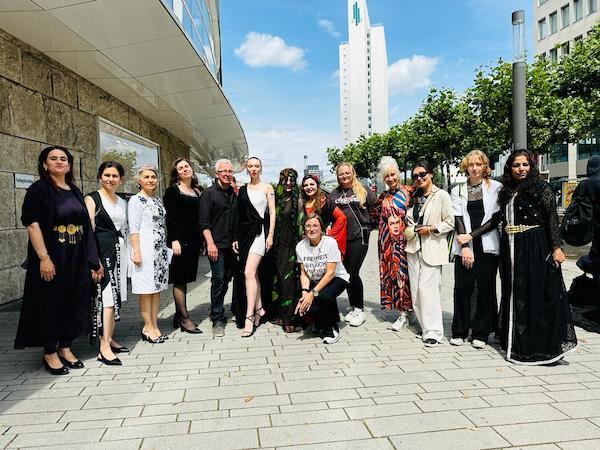The city of Düsseldorf supported our project with funding from the cultural office for the workshops and the economic development agency gave us an exhibition space for the Fashion Days. With the help of Diakonie Düsseldorf and the cooperation of many other people, we were able to realise the project work in the city centre for the Fashion Festival without a budget. A wonderful and new experience for me personally, because in the business of fashion and advertising, no project idea can be realised with pure humanity.
The presentation to the public for the DFD Festival Edition in the middle of the shopping zone during the fashion fair gave the participants an equal appreciation of their artistic work as well as their personal story. Being a woman without restrictions was not as normal for the participants with a recent history of flight as it is for us who live here. To represent an individual attitude through clothing as art was new and very special for all of them.
As designers, we learned a lot of new things about clothes from other cultures and were able to pass them on in conversations at the fashion event. Through fashion, art and clothing, we entered into an exchange with passers-by of all ages and social classes. Integration and migration as polarising topics in our society found an unusual and harmonious place of communication at our stand. The special nature of the dress-art works in the fashion context of the Düsseldorf trade fair offered us a platform with a particularly respectful approach.
A ballet production by the HHU Ballet Company supported our event with expressive dance, attracting the attention of passers-by to our exhibition. Dark escape shirts from Irene’s original Lesbos idea transported the emotion of pain, turmoil and change through movement. Uwe Schimera had decorated his installation “EUROPA” on puppets, which was a permanent eye-catcher in front of our exhibition tent. This escape scenery formed the stage and background for the dance performance and became a fitting intro to our presentation of the individual dress-art works on busts or worn by the participants themselves.
As a purely acoustic programme item, the first articles from the Charter of Human Rights sounded across the square in German to illustrate our commonalities as human beings. Our participants also recited the articles of human rights in their respective mother tongues. In their self-created refugee dress, some read their own texts in German or in their mother tongue, forming the emotional highlight of our presentation.
The printed, personal texts accompanying the dress-art works provided additional exciting insights into the participants’ experiences. This performance got under the skin of our group as well as the interested audience, the professional buyers of the fashion fair and diligents of the city. Young students who experience their normality as migrants here told older people who experienced their childhood in war here that the “European refugee crisis” meant the “great chance for a future” for them in their home country. The exchange of different generations and nations on an emotional level on this Saturday in Düsseldorf made it possible to experience human rapprochement through fashion, art and communication in a natural and respectful closeness.
On 22 July, we staged our conclusion, so to speak, which was already clear after the first workshop: fears and emotions of an experienced flight and migration are absolutely similar and comparable. They are simply human emotions that transcend all national borders and cultures. This summer we experienced with our participants that simple humanity is a connection and bridge across all borders.
Birgit Schwitalla

